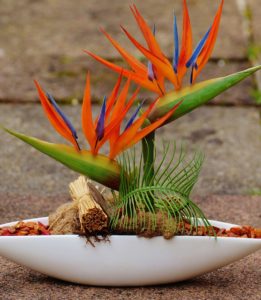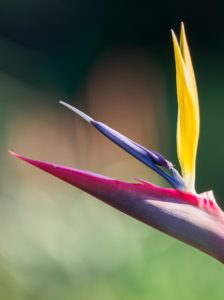Some links in the post are affiliate links and I get a commission from purchases made through some links found in the post.
Bird of paradise (Strelitzia reginae), also known as the ‘crane flower’ is an exquisite ornamental plant.
It is a household plant kept outdoors to add an exotic look to your porches.
Its blooming flowers are a fusion of three bright orange and three blue petals. These flowers usually showcase their beauty when they bloom from March to October.
This plant, due to its exotic flowers, makes a perfect gift. It also symbolises joy and pleasure.
It has a South African origin and is usually grown in warm climates due to its preference for humidity.
Therefore, it is also seen in greenhouses and sunrooms. High temperature tends to keep the roots dry and this prevents the root from getting rot.
Root rot in a birds of paradise plant is mainly caused by overwatering. This then leads to fungal growth. The plant will start to droop as the leaves turn brown and brown.
To fix the root rot for your birds of paradise you will need to remove the plant from it’s pot, remove the damaged roots, Dip the damaged roots in a copper-based fungicide and the repot it.
How Can You Tell If a Bird of Paradise Has a Root Rot?
When your bird of paradise looks sick, lifeless or depressed, it is probably due to root rot.
The plant, when rotten, is unable to absorb the nutrients. Following signs may appear on its parts when there is a root rot:
1) Wilted Leaves
When the root rot appears, the leaves are the first to show the symptoms. The leaves start turning yellow accompanied by wilting, wrinkling and then finally dropping off.
2) Discoloured Leaves
Once the root rot appears, the leaves often start to turn yellow. About sixty per cent of the foliage can be affected.
3) Brown Leaf Tips
The leaves start to turn brown at their tips which is the most evident sign of your plant not being able to thrive due to root rot. The edge might also show a bit of browning taking place.
4) Blackened Roots
The roots of Bird of Paradise are fairly long. When healthy, they are white or tan.
These succulent roots, in case of root rot, turn pale or black in colour. One must check the roots to confirm a root rot.
5) Swollen Stem
A normal stem of the plant is hard and stern. On the other hand, when the plant is inflicted with root rotting, the stem turns swollen and mushy. The swelling progresses from the roots upward.
6) Dying Shoots
If there is root rot, the shoots die back. This makes it difficult for the plants to absorb nutrients.
7) Stunted Growth
Stunted growth can also be a sign of root rot. The plant grows smaller leaves than usual.
It would not grow any new flowers, despite given plenty of fertilisers and proper habitat.
You may also like: why are my birds of paradise plant leaves curling
How Do You Treat Root Rot in Bird of Paradise?
As soon you discover the root rot in your Bird of Paradise, there are a few essential steps you need to follow to treat it in time before the rot takes over the whole foliage.
1) Remove Damaged Roots
 Dig out your plant immediately. This is to make sure if the roots are damaged or healthy.
Dig out your plant immediately. This is to make sure if the roots are damaged or healthy.
The damaged roots are identified by their pale black or brown colour.
After identifying the damaged roots, make sure to remove them. Remove excess plant materials alongside the damaged roots to ensure a clean pot.
Prune around one-third of the foliage after trimming the damaged roots.
2) Use Copper Fungicide
Dip the damaged roots in a copper-based fungicide to get rid of any fungus pestering your precious Bird of Paradise.
Leave your roots out for a while to dry them out. You can always add more perlite, mulch, vermiculite to improve the drainage capacity of the soil.
3) Repot Your Plant
When your plant is tidy enough, it’s ready to be placed in the pot. Make sure there are plenty of drainage holes in your pot to avoid any further root rot.
The holes keep the soil dry. Before planting, you can always wait for your soil to dry out. Re-potting your plant using new soil reduces the risk of developing root rot.
How to Prevent Root Rot in Bird of Paradise?
Root rot can be dangerous to your bird of Paradise but following these preventative measures would be beneficial for it:
1) Avoid Overwatering
Your bird of paradise may lead to root rot. Excess water causes soil to become waterlogged.
This might choke the plant as there is not sufficient oxygen. So, prevent overwatering if you want to save your Bird of Paradise from root rot.
If you need help watering your plant, try using this automatic drip irrigation kit.
2) Use Well Drained Organic Soil
Always use well-drained and rich organic soil for your plant. It takes care of the plant and is a perfect recipe to prevent root rot.
When the roots have all the nutrients they need, they remain healthy and lively. The rich organic soil is a blend of all essential nutrients.
3) Maintain Appropriate Temperature
The plant prefers warm conditions to grow. It does not tolerate lower temperatures.
When the temperature falls, the roots are surrounded by rather wet soil.
This soil deprives the plant of nutrition and makes it susceptible to rotting.
Another reason for the lower temperature to cause a rot is the fact that lower degrees are suitable for many fungi to thrive.
4) Avoid Large Pots
You might think you are doing your plant a favour by providing it with more space. When in reality, this extra-large pot causes the soil to become muddy and damp.
5) Use Copper-Based Fungicides
Copper-based fungi in routine care are also useful to prevent fungal attacks.
Fungal attacks most commonly lead to root rotting conditions. Dip the roots in the fungicides to get rid of the pesky fungus.
6) Avoid Watering During the Dormant Period
Overwatering is already a risk to your plant. It makes the soil excessively moist. If you irrigate your plant during its dormancy, you are definitely asking for root rot.
Final Thoughts
 Whenever your plant sheds more leaves than usual or shows any signs of yellowing, it probably is root rot.
Whenever your plant sheds more leaves than usual or shows any signs of yellowing, it probably is root rot.
Always keep a check to see if the roots are intact. Changing the pot once in a while, avoiding low temperatures and extremely bright sunlight are the prime requirements to prevent this from happening.
While root rot is a serious issue for gardeners, treating the symptoms as soon as they appear can prevent spreading root rot.
Scheduled watering and cleaning of the plant pots will keep your Bird of Paradise fresh and healthy.
Before you go, here are some more related articles I encourage you to read below to help solve more of your gardening issues:
Why are your bird of paradise leaves drooping
How to Save your Snake Plant from Root Rot
How To Save Spider Plant from Root Rot
Top 5 Best Small Trees with Non Invasive Roots
About the Author:
Saad Ansar
Saad is an avid gardener himself and is a great lover of plants, animals, photography, & people. Currently, he is focused on photographing indoor plants & captioning beautiful outdoor sceneries. He writes and rewrites in-depth articles on nature and science.

